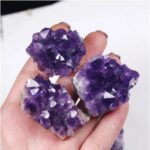In the realm of gemstones, there exists a captivating subset that possesses the extraordinary ability to fluoresce—to emit visible light when exposed to certain wavelengths of ultraviolet radiation. These fluorescent gemstones, each with its own unique hue and intensity, captivate the imagination and add an otherworldly glow to jewelry and décor.

Types of Fluorescent Gemstones
The world of fluorescent gemstones is vast and diverse, encompassing a spectrum of colors and origins:
Diamonds
- Blue Fluorescence: Diamonds exhibit a range of blue fluorescence intensities, from faint to strong, under long-wave ultraviolet light. This fluorescence is typically attributed to trace elements of boron within the diamond’s crystal structure.
- Green Fluorescence: Less common than blue fluorescence, green fluorescence in diamonds is caused by the presence of nitrogen atoms within the crystal lattice.
Emeralds
- Red Fluorescence: Emeralds are known for their characteristic red fluorescence under ultraviolet light. This fluorescence is due to the presence of chromium, which gives emeralds their distinctive green color.
Rubies
- Red Fluorescence: Similar to emeralds, rubies also exhibit red fluorescence under ultraviolet light. This fluorescence is caused by the presence of chromium, which also gives rubies their characteristic red hue.
Sapphires
- Yellow Fluorescence: Many sapphires exhibit a distinct yellow fluorescence under long-wave ultraviolet light. This fluorescence is attributed to impurities such as titanium and magnesium.
- Green Fluorescence: Some sapphires also display a green fluorescence, which is caused by the presence of iron within the crystal structure.
Topaz
- Yellow Fluorescence: Most topazes exhibit a strong yellow fluorescence under ultraviolet light. This fluorescence is caused by impurities such as iron and titanium.
Fluorite
- Various Colors: Fluorite is a highly fluorescent mineral that emits a wide range of colors under ultraviolet light, including blue, green, purple, and yellow. This fluorescence is due to the presence of various trace elements within the fluorite crystal structure.
Calcite
- Orange Fluorescence: Calcite is another highly fluorescent mineral that emits an orange glow under ultraviolet light. This fluorescence is caused by the presence of manganese impurities.
Factors Affecting Fluorescence Intensity
The intensity of fluorescence in gemstones varies depending on several factors:
- Concentration of Activator Elements: The intensity of fluorescence is directly proportional to the concentration of the activator elements (e.g., chromium, boron) within the gemstone’s crystal structure.
- Crystal Structure: The type and arrangement of atoms within the crystal structure can influence the intensity of fluorescence.
- Impurities: The presence of impurities can enhance or diminish fluorescence depending on their type and concentration.
- Wavelength of UV Light: The wavelength of the ultraviolet light used can also affect the intensity of fluorescence.
Applications of Fluorescent Gemstones
Beyond their aesthetic appeal, fluorescent gemstones offer a wide range of applications:
- Gemological Identification: Fluorescence can assist in identifying and distinguishing gemstones, as different gemstones exhibit unique fluorescence colors and intensities.
- Medical Applications: Some fluorescent gemstones, such as fluorite and calcite, are used in medical imaging and therapy due to their ability to absorb and emit specific wavelengths of light.
- Scientific Research: The fluorescence properties of gemstones are used in scientific research to study the composition and structure of materials.
- Gemstone Enhancement: Fluorescence can be used to enhance the appearance of some gemstones, making them more attractive and valuable.
- Decorative Applications: Fluorescent gemstones are often used in decorative lighting fixtures, sculptures, and other objects to create eye-catching and dynamic effects.
Table 1: Fluorescence Colors and Associated Gemstones
| Fluorescence Color | Gemstone |
|---|---|
| Blue | Diamond |
| Green | Diamond, Sapphire |
| Red | Emerald, Ruby |
| Yellow | Topaz, Sapphire |
| Orange | Calcite |
| Various | Fluorite |
Table 2: Factors Affecting Fluorescence Intensity
| Factor | Effect |
|---|---|
| Concentration of Activator Elements | Intensity increases with increasing concentration |
| Crystal Structure | Can enhance or diminish intensity |
| Impurities | Can enhance or diminish intensity depending on type and concentration |
| Wavelength of UV Light | Lower wavelengths typically result in higher intensity |
Table 3: Applications of Fluorescent Gemstones
| Application | Gemstone |
|---|---|
| Gemological Identification | Diamonds, Emeralds, Rubies, Sapphires, Topaz |
| Medical Applications | Fluorite, Calcite |
| Scientific Research | Fluorite, Calcite |
| Gemstone Enhancement | Diamonds, Sapphires |
| Decorative Applications | Fluorite, Calcite, Topaz |
Strategies for Enhancing Fluorescence
Several strategies can be employed to enhance the fluorescence of gemstones:
- Use a High-Intensity UV Light: High-intensity ultraviolet light will produce stronger fluorescence.
- Choose the Right Wavelength: The wavelength of the UV light should match the absorption spectrum of the gemstone.
- Clean the Gemstone: Surface impurities can block UV light and reduce fluorescence.
- Consider Heat Treatment: Heat treatment can sometimes enhance the fluorescence of certain gemstones.
Conclusion
Fluorescent gemstones, with their captivating glow and diverse applications, offer a testament to nature’s artistry and scientific intrigue. From illuminating jewelry to aiding in medical procedures, these gemstones continue to captivate and inspire. As researchers continue to explore the properties of fluorescent materials, we can anticipate even more innovative and enchanting applications in the future.



























